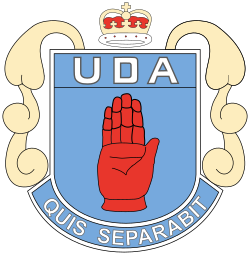Ulster Defence Association
| Ulster Defence Association (UDA) | |
|---|---|
| Participant in the Troubles | |

Above: UDA emblem
Below: UDA flag |
|
| Active | September 1971–present (on ceasefire since October 1994; ended armed campaign in November 2007) |
| Ideology |
Ulster loyalism British unionism Right-wing politics Ulster nationalism (briefly) Anti-Catholicism |
| Leaders |
Charles Harding Smith (1971–1973) Jim Anderson de facto (April–December 1972); joint chairman (December 1972 to spring 1973) Andy Tyrie (1973–1988) Commander of the UFF John McMichael (until 1987) Inner Council Jackie McDonald, Johnny Adair, Jim Gray, Andre Shoukri, James Simpson, South East Antrim Commander John Gregg, Billy McFarland, Matt Kincaid |
| Headquarters | Belfast |
| Area of operations |
Northern Ireland (mostly) Republic of Ireland |
| Strength | 40,000 at its peak (1972), under 1,000 at the end of its armed campaign |
| Allies |
Loyalist Volunteer Force, Red Hand Defenders (until 2002) |
| Opponents |
Irish Republican Army Irish republicans Irish nationalists |
The Ulster Defence Association (UDA) is the largestUlster loyalist paramilitary and terrorist group in Northern Ireland. It was formed in September 1971 and undertook a campaign of almost twenty-four years during the Troubles. For most of this time it was a legal organisation. Its declared goal was to defend Ulster Protestant loyalist areas and to combat Irish republicanism, particularly the Provisional Irish Republican Army (IRA). In the 1970s, uniformed UDA members openly patrolled these areas armed with batons and held large marches and rallies. Within the UDA was a group tasked with launching paramilitary attacks; it used the covername Ulster Freedom Fighters (UFF) so that the UDA would not be outlawed. The British government outlawed the "UFF" in November 1973, but the UDA itself was not proscribed as a terrorist group until August 1992.
The UDA/UFF terrorists were responsible for more than 400 deaths. The vast majority of its victims were Irish Catholic civilians, killed at random, in what the group called retaliation for IRA actions or attacks on Protestants. High-profile attacks carried out by the group include the Milltown massacre, the Sean Graham bookmakers' shooting, the Castlerock killings and the Greysteel massacre. Most of its attacks were in Northern Ireland, but from 1972 onward it also carried out bombings in the Republic of Ireland. The UDA/UFF declared a ceasefire in 1994 and ended its campaign in 2007, but some of its members have continued to engage in violence. The other main loyalist terrorist group during the conflict was the Ulster Volunteer Force (UVF). All three groups are Proscribed Organisations in the United Kingdom under the Terrorism Act 2000.
...
Wikipedia

